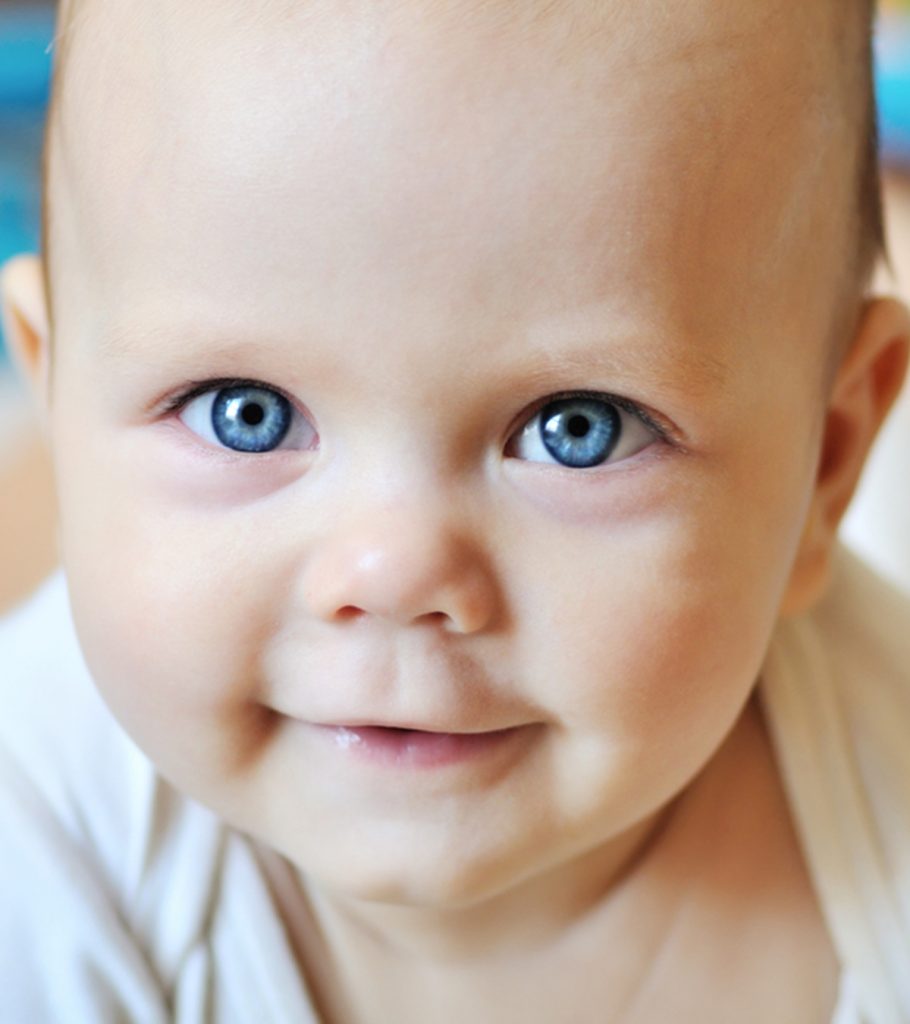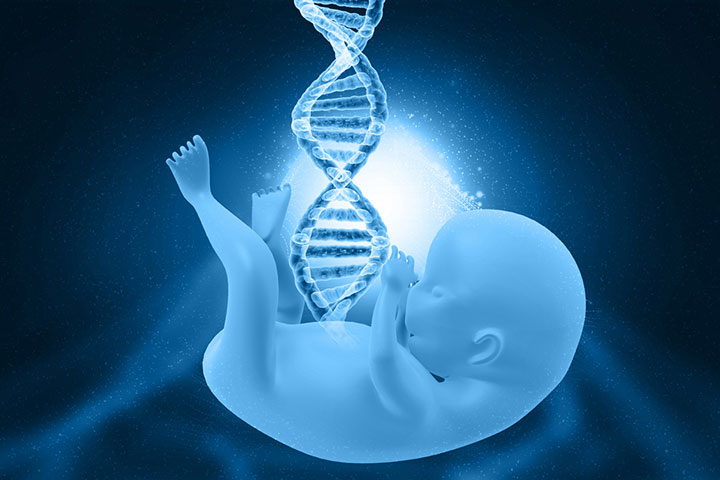Anticipating the color of a baby’s eyes may excite many expecting parents. Many parents believe that all babies are born with blue eyes, and the color changes as they age. Parents may also take a cue from their eye colors and guess the possible eye color of their baby.
Blue eye color is many parents’ favorite, though. But are all babies really born with blue eyes? Also, can a baby be born with blue eyes even if none of the parents have blue eyes? Read the post to know the factors determining and regulating babies’ eye color.
Do All Babies Have Blue Eyes At Birth?
No, not all babies are born with blue eyes. The eye color is determined by the eye color genes found on chromosome 15 and the possible interplay of some other genes. No two sets of parents have exactly similar genes even within the same family tree. Since each parent has their unique genes and gene expression, it is not necessary that all babies be born with blue eyes (1).
What Determines Eye Color?
Eye color comes from the iris, the striated tissue controlling the aperture of the pupil, which is the central hole of the eye. When we see someone’s eyes and notice their eye color, we see the iris and its color.
The color of the iris is primarily determined by a couple of genes called OCA2 and HERC2 found on chromosome 15. These regulate the amount of melanin present in the iris tissue (2). Melanin in the iris is the same pigment found in our skin. Brown eyes have the most amount of melanin, while blue eyes have the least. In those with blue eyes, the iris is not precisely blue. It only appears so due to scattering of the different light’s wavelengths by the stroma, the upper layer of the iris (3).
A baby receives one allele (gene variant) from each parent, who will transfer an allele based on the eye color genes received from their parents. Alleles for darker eyes with more melanin, such as brown, are considered dominant over those with less melanin, such as blue. Therefore, it may lead to the following possibilities (4).
- Two blue-eyed parents will have a higher chance of having a blue-eyed baby.
- Two brown-eyed parents will have a higher chance of having a brown-eyed baby.
- One parent with blue eyes and another with brown eyes will have nearly equal chances of having a blue-eyed or brown-eyed baby, although the chances of having a brown-eyed baby will be slightly higher.
- Two brown-eyed parents will have a slight chance of having a blue-eyed baby if any of the little one’s grandparents have blue eyes.
The same chances apply when a brown-eyed parent is replaced with a parent with any other color darker than blue, that is, other iris shades with more melanin, such as green and hazel. These are approximate possibilities of a baby’s eye color at birth, and several genetic factors could influence the outcome.
What Can Cause Blue Eyes At Birth?
There are babies who are indeed born with blue eyes. A baby could have blue eye color at birth for the following reasons.
1. Genetics
Genes play a significant role in determining the baby’s eye color. The following conditions and scenarios related to genes could lead to blue eyes in babies.
- Family inheritance:A baby is more likely to have blue eyes when their parents and grandparents have blue eyes. It is likely the reason why blue eyes tend to be more common among certain human populations. These people have a gene pool with predominantly blue iris alleles.
- Random allele expression: It is not uncommon for brown-eyed parents to have a baby with blue eyes. In such cases, one of the parents could be a carrier of a blue iris allele passed down from generations but without any expression. The blue iris gene variant may randomly pass down and be expressed in the progeny, causing them to have blue eyes (5).
- Interaction with other genes:Research suggests that the genetics of eye colors is more complex than believed since the eye color genes may interact with genes involved in determining hair and skin color (1). Therefore, in rare cases, a baby may be born with blue eye color without a family history or the presence of dormant blue iris alleles.
2. Syndromes and conditions
There are some genetic conditions, syndromes, or disorders that could cause blue eyes in babies. In many cases, the blue eyes may not appear at birth and manifest a few days or weeks after birth.
- Ocular albinism: It is a genetic condition causing total loss of melanin in the iris. It causes eyes to become lighter, eventually turning to a pale shade of blue. The condition is a result of genetic mutations, and it could be congenital (present at birth), occurring more commonly in boys than girls (6). Babies with ocular albinism do not always show skin or hair albinism. However, vision problems, such as blurred vision, are common. In rare cases, the child may experience vision loss in the long term (7).
An anonymous blogger and mom shares her experience of how her son Luke was diagnosed with ocular albinism. She writes, “My husband noticed the lazy eye before I did. The pediatrician said that if it was still there at six months, we should get it checked out. So we waited. Around four months, I started seeing the “rolling.” We kept hoping that it was just a lazy eye…maybe I was imagining things. At six months, he was diagnosed with Ocular Albinism (i).”
- Waardenburg syndrome: It is a genetic disorder, which is often congenital. It occurs due to mutant genes, which are mostly inherited, causing the syndrome to run in families. There are different types of Waardenburg syndrome with various signs. Hearing loss can occur in one or both ears. Some of the notable signs are a wider gap between the eyes and the presence of pale blue eyes (8). Some babies have different pigmentation across the irises, with one eye being blue and another of a different shade. This condition is called heterochromia. In rare cases, the eye with a darker color may undergo a transformation and become blue as the child grows into a toddler or older.
- Heterochromia: It is a condition that causes variation in eye color. Some babies may be born with only one blue eye. Heterochromia could be a result of random genetic mutation not associated with any problem. It is known as benign heterochromia. In some cases, it may be a sign of a genetic disorder. Some genetic disorders that could cause heterochromia are Waardenburg syndrome, Sturge-Weber syndromeiXA congenital neurological condition characterized by a port-wine stain mark on the forehead and region around the eyes., Hirschsprung diseaseiXA rare condition affecting the large intestine, leading to difficulty passing stools in babies., and Horner’s syndromeiXA neurological syndrome caused due to interrupted nerve supply to the eye, leading to smaller pupils and drooping eyelids. (9).
In rare cases, babies may develop blue eyes or heterochromia due to birth injuries or other injuries in a few days or weeks after birth.
Does A Baby’s Eye Color Change?
Yes. The hue of the infant’s iris could keep varying during the first year. The color change could be more often during the first six months, slowing down between six months and 12 months (4). The reason behind changes in eye color is the lack of fully developed melanin (10). It usually takes nine to 12 months for the melanin in the baby’s iris to set in its place, giving the eyes their final color.
Sometimes, a baby’s blue eyes may gradually transform into brown as the melanin develops completely. However, it is quite rare and seldom occurs in babies who have inherited blue eyes. Nevertheless, it indicates that you may only be able to tell the final eye color of the baby’s eyes after they complete their first birthday. You may take the help of our baby eye calculator to determine the possible color of your baby’s eyes.
When To Be Concerned?
Eye color is usually not something to be concerned about since it develops on its own. However, you may consult a pediatrician or a pediatric ophthalmologist if you notice the following signs or conditions in the baby (11).
- Development of heterochromia
- Rapid changes in eye color
- Presence of freckles or mottled appearance of the iris
- Eye color changes accompanied by reddening of the sclera or dilation of the pupil
- Baby displays possible signs of a genetic disorder, such as unusual physical features
- Changes in eye color after an injury
Eye color is one of the fascinating attributes of our body, and parents are likely to be curious about their baby’s eye color. Remember not to fret or be overly concerned about the baby’s eye color since it is mostly governed by genetics. Experts recommend that you get the baby’s first eye exam at six months, irrespective of whether the infant has any problem (12). Speak to an ophthalmologist if you have any concerns about your baby’s eye color or appearance.
A popular misconception is that all newborns are born with blue eyes. Children’s eye color might differ due to heredity and other reasons. Even blue-eyed parents can have kids with varied eye colors. The pigments that give the eye color are found in the iris, a component of the eye, and genes on chromosome 15 regulate it. There is a larger possibility of having a baby with blue eyes if both parents are blue-eyed. Eyes that are pale blue in color can be caused by a variety of disorders, including ocular albinism.
Key Pointers
- The eye color of an individual is determined by the genes found on chromosome number 15.
- Two blue-eyed parents have a greater chance of having a baby with blue eyes.
- The baby’s eye color may keep changing during the first year.
Have you ever wondered why all white babies are born with blue eyes? Let’s explore the science behind this phenomenon and find out why!














